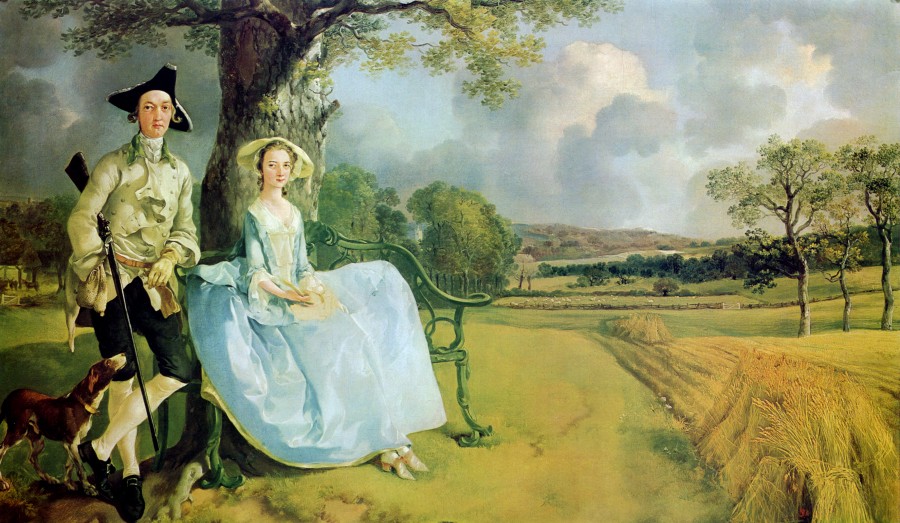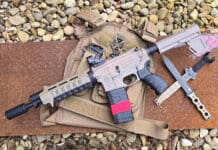Back in college I took an art history class. I had a fantastic teacher, one who I knew for a fact could take a joke and appreciate good satire. Which is why I wrote this comparison piece for her class, comparing the classic English portrait by Gainsborough of Mr. and Mrs. Andrews to the more contemporary portrait of a man known as Micromancer (image NSFW). And, because it’s a slow news day, I thought you all might enjoy a bit of fine art appreciation . . .
Throughout the ages, newer artists have always paid homage to older masters while simultaneously redefining the medium in which they work. Much like the masters of the Dada movement, Micromancer in his untitled work is referring back to the English school, and specifically Thomas Gainsborough’s 1750 masterpiece Mr. and Mrs. Andrews.
Social status in England in the 1700s was dependent on nobility and wealth, and as such the majority of English decoration was focused on displaying that wealth to all who entered the home. The English school of art was no different, and so focused on displaying the wealth of the patron, including all his possessions.
For this reason, Mr. Andrews in his painting on a vast and fertile field to display his status as a landed gentleman and his ability to generate income through his farm. Not shown as property but instead implied by the farm are his workers, people he would have had to hire to care for the crops and livestock visible in the background. His ability to pay these individuals speaks to Mr. Andrews’ wealth more than the land.
Included in the painting is also a firearm, held in the crook of Mr. Andrews’ arm as if he were comfortable with it. The right for citizens to own guns was established in England in 1707, merely 43 years before, and as such firearm ownership would have still been uncommon, leading the older viewers to have an even higher impression of Mr. Andrews. In addition, the fine workmanship required to produce a sporting rifle of that type would have required considerable effort on the part of a gunsmith, and subsequently a considerable investment on the part of the owner who purchased it.
Finally, the last possession chronicled by the painting is his wife, Mrs. Andrews. Wives were still considered property in this time, and a beautiful wife (such as is displayed in this work) would have been a much valued asset.
Much like the landed gentry of 1700s England, Tennessee culture in the United States is stratified generally by the property one owns and the wealth they possess. In a similar vein to Gainsborough, the setting for Micromancer’s untitled work is his basement, where (as research has shown) he runs a computer repair business. While the setting is not necessarily consistent with the wide tracts of land Gainsborough so loved, the sentiment is identical. Both works show the patron in a location where he accumulates wealth. While Mr. Andrews’ farms are his source of income, Micromancer’s dingy basement is his place of employment.
But what speaks the most to the patron’s wealth is the firearms displayed on the bed next to him. Like Mr. Andrews’ rifle, each firearm symbolizes a significant investment on the part of the owner. And while each firearm is itself an investment, the biggest symbol of wealth in this photograph is the pile of ammunition on the bed.
In these troubled times, ammunition prices have been skyrocketing, making shooting firearms a more cash-intensive hobby than ever. The variety of calibers displayed on the bed, in connection with the sizable stockpile displayed, show that the owner not only has the wealth to buy the firearms, but also enough capital and income to keep those firearms stocked with ammunition. Micromancer is also shown holding a firearm casually, as if comfortable with its use.
Not mentioned in Gainsborough’s work was recreation. A significant part of a person’s life, whether they be born in 1700’s England or 1970’s Tennessee, is recreation. Such diversions may have been frowned upon by Gainsborough, but Micromancer has included two Guitar Hero guitars, iconic images that correlate to significant investments in entertainment equipment.
One other difference in the works is the presence of a wife. While Gainsborough shows Mrs. Andrews prominently in his work, Micromancer leaves his wife (which research shows he had at least one) completely out of the picture. This may be attributed to the changing attitudes of humanity and specifically a result of the woman’s rights movement.
Also interesting to note is the attire of Micromancer. Unlike Gainsborough, Micromancer decided to show himself in a garment that is not considered to be socially acceptable. However, rather than an affront to Gainsborough, this is more a nod to photographer Robert Mapplethorpe, and specifically his legendary photograph Brian Ridley and Lyle Heeter, a photograph that was also controversial in its day and showed two homosexual men in S&M outfits in the 1970s.
Micromancer’s untitled work may, on the surface, seem to only be a one-trick pony, simply designed to shock the viewer and induce laughter. However, after a careful comparison, we can see how Micromancer is instead updating an English masterpiece for today’s world.






A guy like Micromancer might introduce you to his wife and his sister, and they’d be the same woman.
Puwahahaha.
Aren’t you a lawyer Ralph? Maybe you can answer this question for me. If a man and wife in Arkansas get a divorce, are they still legally brother and sister?
Well played, good sir. You managed to get me to look at the burly man beast. This is the Thinking Man’s Rick Roll.
Also, I like your interpretation of the art. It reminds me of hanging with an art student friend in college and having to point out to her, that all of her other friends were pretentious. Three scribbles in pencil on a 6′ long piece of white paper does not make you an artist.
That photo hurt my eyes.
Years ago at an art museum there was what appeared to be a 4’x8′ sheet of plywood with a green, gray and another green stripe running length wise.
Haven’t been back since, guess I just don’t appreciate fine art.
Well played, sir. Well played.
I see Hot Lips magazines for a 10/22, but see no 10/22. I call shenanigans!
Nice report, Nick.
Is that what Klingons look like after forehead surgery ?
That picture is so, so disturbing.
I’ve always wanted to know why he is wearing a thong. Do you really think a woman is going to find that picture attractive?
I love you micromancer. You are a man among boys! <3 :glomp:
trolled me good.
Nice one..
The second picture was a but hard to digest tough.
My favorite story about modern art was an incident in a London art museum. It seems that an artist had created a work of art for the museum, at a cost of 20,000 Pounds. Overnight, the artwork had disappeared. After an intensive investigation by the police, it turned out that a member of the museum’s cleaning staff had thrown out the art with the trash.
The work of art? A green garbage bag full of crumpled sheets of yellow paper, leaning against a display pedastal.
The artist felt that he might be able to create another similar artwork for the museum, but it would cost 30,000 Pounds this time.
Your Micromancer image would probably be worth 50,000 Pounds to that museum.
Comments are closed.